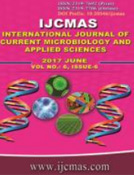


 National Academy of Agricultural Sciences (NAAS)
National Academy of Agricultural Sciences (NAAS)

|
PRINT ISSN : 2319-7692
Online ISSN : 2319-7706 Issues : 12 per year Publisher : Excellent Publishers Email : editorijcmas@gmail.com / submit@ijcmas.com Editor-in-chief: Dr.M.Prakash Index Copernicus ICV 2018: 95.39 NAAS RATING 2020: 5.38 |
Dryland horticulture constitutes major part in horticulture crop production. Moisture stress is one of the major limiting factor in production of mango in dryland horticulture, since the rainfall is highly erratic and it is not possible to utilize available rainwater efficiently. Mango is one of the major crop grown in Ramanagara district covering an area of 22172 ha. Due to poor soil and water conservation practices in mango moisture retention is low in the soil that affects productivity. In this context, front line demonstration on Micro-catchment techniques was conducted in the mango grower’s field in an area of 6ha. Micro-catchment techniques means development of small structures across land slope which captures surface runoff and stores in plant zone for subsequent plant use. Micro-catchment techniques including half-moon, V-shaped, and diamond shaped bunds were constructed across each mango plant. Further vetivera grass was planted over the catchment bund to control erosion. Highest average mean fruit yield/tree was recorded in half-moon water harvesting system and is significantly superior to other water harvesting system and minimum was in control plots. The fruit yield was increased by 22.2% in compare with control and B:C ratio was found to be 2.9. The demonstrated area received annual average rainfall of 21.8mm which conserves110ltrs of water per catchment. Several educational programmes were conducted to popularize Micro-catchment techniques.
 |
 |
 |
 |
 |